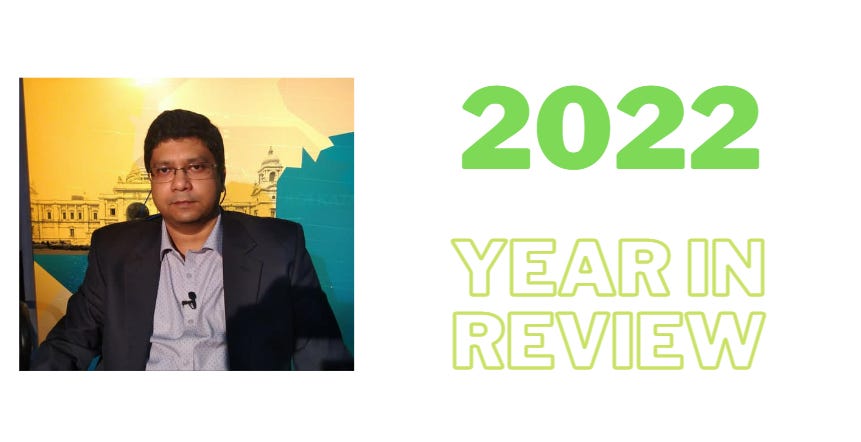
We are again at that time of the year when people don their thinking hats and reflect on the year gone by. As an investor, I find it very important to reduce my regular investment work and go back and think about what went right and what could be improved upon.
This last week, I actually was inspired by the “Think Week” ritual that Bill Gates used to have. Unlike Gates, I did not go off to a reclusive lake-side retreat all by myself. But I did reduce a lot of my regular work and went back to my pen and diary (sometimes OneNote journal) to look back and also to look forward.
2022 - The year gone by:
Some of the memorable events during the year which we will probably remember for some time were:- Start of the Russia-Ukraine war.
- As per the IMF projections, India surpassed the UK to become the fifth-largest economy.
- The world population reached 8 billion on November 15, with India being the largest contributor to the milestone, according to the United Nations (UN). India added 177 million to the final score.
- After a legal battle, Elon Musk finally bought Twitter for $44 billion.
- Sri Lanka had a major economic crisis precipitated by Covid.
- Former Tata Sons Chairman Cyrus Mistry passed away in a car crash in Palghar.
- Rahul Bajaj, the chairman emeritus of the Indian conglomerate Bajaj Group, passed away. He was awarded the third-highest civilian award in India, the Padma Bhushan, in 2001.
- Passing away of Queen Elizabeth II, the longest-serving British monarch.
- Covid continued to rear its head from time to time and now is seeing an increase in some countries like China, which has done a 360-degree turnaround from a zero-Covid policy to a completely open policy in a matter of days.
Investing in 2022
This year was gruelling. Stocks went up and then came back time and again. So much so that most of them were flat by the year's end. Making money was difficult. Sometimes, when you do a retrospective analysis, it is difficult to figure out how tough it was, because you tend to ignore the intermediate drawdowns thinking you would have held on during them. Also, some feel that since you have “good quality” stocks, it is better to hold on to them, because they eventually come back up. This may not be always true, at least in the timeframe you are looking at. Sometimes, stocks of even great companies take years and even decades to reach their previous highs. One must always be cognizant of the opportunity cost of alternatives while investing.
2023 - What lies in store?
India is looking to be on a relatively strong wicket. After nearly a decade, banks have cleaned up their balance sheets and overall credit growth is picking up. The credit growth of banks is at a 10-year high of 17.5%.
With just one more full budget before the 2024 elections, the expectation of a growth-led budget is high. Strong investment capex and social policies leading to incremental buying power for the masses augur well for consumer-facing companies. Government capex is at an 18-year high at 2.5% of GDP in 1HFY23. The PLI scheme-led investment is leading private capex. Just the trio of Tata, Ambani and Adani groups are planning an investment of $215bn in the next 5 yrs.
The really big investments are happening in the transition sectors: green energy, EV, 5G and tech/digital. This tailwind is being supported by the realignment of global supply chains – China+1, friendshoring etc.
We are likely to see a peaking of inflation and stabilisation of interest rates, but inflation will not cool off easily. The big components of inflation in India have historically been oil and food. How oil prices behave is anybody’s guess but food inflation is not likely to come down much going by history. In addition, with China back in the global economy, there is expected to be significant demand for oil, metals and other commodities. Chinese markets have probably already bottomed out since we discussed this during the middle of the year.
What should we do?
Markets are likely to remain choppy atleast in H1FY24. Domestic consumption and capex-oriented plays are likely to perform better. Sectors like engineering, capital goods, infrastructure, real estate and autos are likely to remain at the forefront.
Select IT and pharma companies can be identified and added slowly into the portfolio.
It is likely to continue to be a buy-on-dips kind of market for the next 2-3 yrs. It is better to continue sipping into the portfolio stocks or adding capital to your portfolio every month.
Now is not the time to be afraid. It is the time to ignore the noise and silently accumulate.











